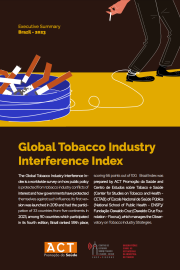
O Índice global sobre a Interferência da Indústria do Tabaco é uma pesquisa mundial sobre como as políticas públicas estão protegidas de conflito de interesses da indústria do tabaco e como e como os governos têm se protegido contra tal influência.
Índice da Interferência da Indústria do Tabaco - Sumário Executivo. ACT PROMOÇÃO DA SAÚDE; CENTRO DE ESTUDOS SOBRE TABACO E SAÚDE. Rio de janeiro, 2023. 4p.
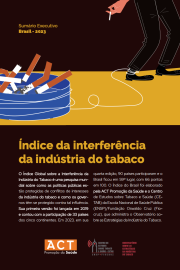
O Índice global sobre a Interferência da Indústria do Tabaco é uma pesquisa mundial sobre como as políticas públicas estão protegidas de conflito de interesses da indústria do tabaco e como e como os governos têm se protegido contra tal influência.
Índice da Interferência da Indústria do Tabaco - Sumário Executivo. ACT PROMOÇÃO DA SAÚDE; CENTRO DE ESTUDOS SOBRE TABACO E SAÚDE. Rio de janeiro, 2023. 4p.
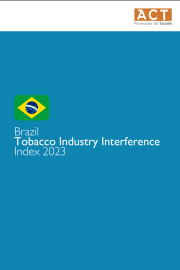
The Global Index Tobacco Industry Interference is a worldwide survey of how public policy is protected from tobacco industry conflicts of interest and how governments have protected themselves agains such influence.
Índice de interferência da indústria do tabaco. ACT PROMOÇÃO DA SAÙDE; CENTRO DE ESTUDOS SOBRE TABACO E SAÚDE. Rio de Janeiro, 2023. 75p.
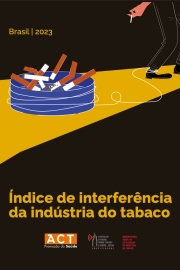
O Índice Global sobre a Interferência da Indústria do Tabaco é uma pesquisa mundial sobre como as políticas públicas estão protegidas de conflitos de interesses da indústria do tabaco e como os governos têm se protegido contra tal influência. Sua primeira versão foi lançada em 2019 e contou com a participação de 33 países dos cinco continentes. Em 2023, em sua quarta edição, 90 países participaram e o Brasil ficou em 59o lugar, com 66 pontos em 100. O Índice do Brasil foi elaborado pela ACT Promoção da Saúde e o Centro de Estudos sobre Tabaco e Saúde (CETAB) da Escola Nacional de Saúde Pública (ENSP)/Fundação Oswaldo Cruz (Fiocruz), que administra o Observatório sobre as Estratégias da Indústria do Tabaco.
Índice de interferência da indústria do tabaco. ACT PROMOÇÃO DA SAÙDE; CENTRO DE ESTUDOS SOBRE TABACO E SAÚDE. Rio de Janeiro, 2023. 75p.
De acordo com a acima exposto, informamos que os documentos indexados na Seção “Interferências” do Observatório se referem, de maneira geral, a organizações e/ou pessoas identificadas com a indústria do tabaco (como parceria ou através de financiamento direto ou indireto de entidades, pessoas e projetos) ou alternativamente, que promovam ou defendam os interesses da indústria fumageira através de declarações públicas, projetos colaborativos, ou através de associações com organizações que tenham vínculo direto ou indireto com a indústria fumageira. No caso DIRETA, que através de interpelação extrajudicial direta questionou o fato de estar entre as organizações que identificadas com a indústria do tabaco, informamos que a mesma foi identificada como uma instituição que de fato, se encaixa nesta definição pelas razões descritas na carta.
DECLARAÇÃO do Cetab/Ensp/Fiocruz à organização Direta. Cetab/Ensp/Fiocruz. Rio de Janeiro, 2023. 4p.
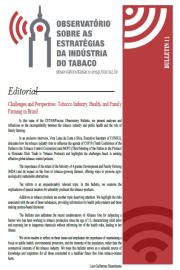
Bulletin eleven published by the Center for Studies on Tobacco and Health of the Sergio Arouca National School of Public Health of the Oswaldo Cruz Foundation (Cetab/Ensp/Fiocruz). This edition consists of an editorial signed by Luis Guilherme Hasselmann; opinion on the re-creation of the Ministry of Agrarian Development; interview with Vera Luiza da Costa e Silva – Executive Secretary of the National Commission for the Implementation of the Framework Convention (CONICQ) and other news.
DESAFIOS e perspectivas: indústria do tabaco, saúde e agricultura familiar no Brasil [boletim ONZE]. Cetab/Ensp/Fiocruz, Rio de Janeiro, n. 11, 19 set. 2023.
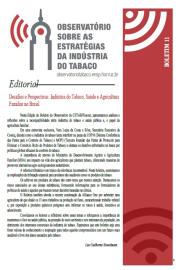
Boletim onze publicado pelo Centro de Estudos sobre Tabaco e Saúde da Escola Nacional de Saúde Pública Sergio Arouca da Fundação Oswaldo Cruz (Cetab/Ensp/Fiocruz). Esta edição é composta por: editorial assinado por Luis Guilherme Hasselmann; opinião sobre a recriação do Ministério do Desenvolvimento Agrário; entrevista com Vera Luiza da Costa e Silva – Secretária Executiva da Comissão Nacional para a Implementação da Convenção Quadro (CONICQ) e notícias extras.
DESAFIOS e perspectivas: indústria do tabaco, saúde e agricultura familiar no Brasil [boletim ONZE]. Cetab/Ensp/Fiocruz, Rio de Janeiro, n. 11, 19 set. 2023.
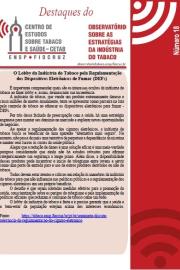
Folheto com os tópicos considerados de destaque com o intuito de promover debates e tomadas de decisão no âmbito do controle do tabaco. Nesta edição, a pauta versa sobre: o lobby da Indústria do Tabaco pela Regulamentação dos Dispositivos Eletrônicos de Fumar (DEFs); reforma tributária: um passo importante para a Saúde Pública; um olhar crítico sobre a indústria do tabaco e DEFs: um perigo crescente para fumantes passivos em ambientes fechados.
KORNALEWSKI, Alex Medeiros; CARVALHO, Alexandre Octavio Ribeiro de; BARATA, Danielle; HASSELMANN, Luis Guilherme; TURCI, Silvana Rubano. Destaques do Observatório sobre as Estratégias da Indústria do Tabaco. Cetab/Ensp/Fiocruz, Rio de Janeiro, jul. 2023. Acesso em: 31 jul. 2023.
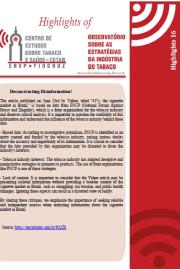
Highlights with topics considered to be of note in order to promote debates and decision-making in the context of tobacco control. In this edition, the agenda deals with: deconstructing the information disseminated by the National Forum Against Piracy and Illegality; The truth about the partnership between Deputy Marcelo Moraes and the tobacco industry; Clearance of Electronic Smoking Devices (EDS): A Threat to Youth Health! and the truth behind ESG strategies: Unmasking the tobacco industry and SindiTabaco.
KORNALEWSKI, Alex Medeiros; CARVALHO, Alexandre Octavio Ribeiro de; BARATA, Danielle; HASSELMANN, Luis Guilherme; TURCI, Silvana Rubano. Destaques do Observatório sobre as Estratégias da Indústria do Tabaco. Cetab/Ensp/Fiocruz, Rio de Janeiro, jul. 2023. Acesso em: 7 jun. 2023.
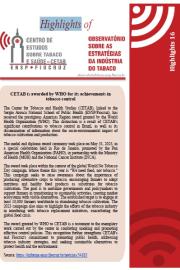
Highlights with topics considered to be prominent in order to promote debates and decision-making in the field of tobacco control. In this edition, the agenda is about: CETAB is awarded by the WHO for its achievements in tobacco control; tobacco industry interference in COP10 and MOP3: a legitimate concern; the tobacco industry and the need for taxation for tobacco control; campaign "The world needs food, not tobacco": promoting alternatives for workers.
KORNALEWSKI, Alex Medeiros; CARVALHO, Alexandre Octavio Ribeiro de; BARATA, Danielle; HASSELMANN, Luis Guilherme; TURCI, Silvana Rubano. Destaques do Observatório sobre as Estratégias da Indústria do Tabaco. Cetab/Ensp/Fiocruz, Rio de Janeiro, jun. 2023. Acesso em: 6 jun. 2023.
